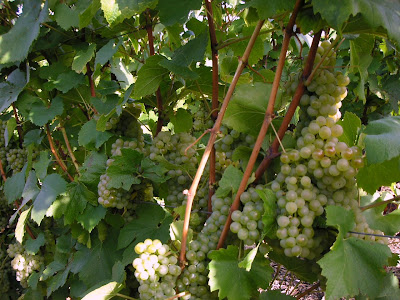 Chardonnay-grapes from the harvest of records in 2004.
Chardonnay-grapes from the harvest of records in 2004.To grow grapes is an occupation that demands an ability to stay cool. I have said it before. But facts often explains much more frankly than words, so here goes.
The numbers below give an overview of the years 1996-2005. They were published in the december 2006 edition of the magazine Le Vigneron Champenois.
10 years with the grapes
The overview contains the dates for débourrement, full flowering and grapeharvest for the three varieties of grapes, that are the far most common ones in Champagne: Chardonnay (green), Pinot Noir (blue) og Meunier (blue).
In those 10 years the vines have generally unfolded around April 15th, they flowered around June 15th, and the grapeharvest began around September 18th. To find bigger variations - such as the days where the grapeharvest took place in October - you need older dates than those of 1996. The table shows the earliest and the latest date for unfolding, flowering and harvest:
| Chardonnay | Pinot Noir | Meunier |
|---|---|---|
| 29.03.03-18.04.96 | 05.04.97-21.04.96 | 08.04.03-23.04.96 |
| 07.06.03-19.06.01 | 07.06.03-21.06.01 | 08.06.03-22.06.96+01 |
| 25.08.03-27.09.04 | 25.08.03-27.09.04 | 25.08.03-25.09.01+04 |
If you study the dates a bit more, especially 2003 differs from the other years. And 2003 was a year, that had quite a lot of unpleasantness to offer.
This year the winter was cold in Champagne. It got warmer, even pleasantly mild already from mid February. The warmth made the vines develop early, and when the spring frost arrived in the end of April the destructions were rather extensive. Alain brought these bad news on my very last work day in Copenhagen.
Those days I didn't get the seriousness of the message. I have understood more since. I believe, that the numbers of Le Vigneron Champenois still today make quite an impression:
Reservewines and heatwave
The individuel reserve of wines, that winegrowers are authorized to store here in Champagne, has been agreed excactly to prepare themselves for this kind of very expensive surprises, that come with special weather some years.
It will be interesting to follow the development these next years. Will there be more warm winters like this one? How will it affect the unfolding of the vines? Will there be even more problems with frost in spring than before caused by an early unfoldning? Will the spring frost be more rare as the weather warms? We shall see.
The frost was not the last meteological accident of 2003. Since followed a very warm summer, that cost thousands of old French people their lives. The heatwave also made the grapes mature so fast, that the grapeharvest had to begin with only a few days notice. We were on holidays and only made it for the last day.
The determinating factor is, that the content of sugar exceeds a certain limit. Shortly after the grapes must be harvested, otherwise it is hard to keep the common alcohol level of a champagne of 12,5 percent. The heat wave also made the important acidity of the grapes of vintage 2003 unusually low.
The very small amount of grapes of 2003 (7.500 kilos per hectare) wes replaced by another extraordinary year in 2004, where the vines carried legendary 23.000 kilos per hectare. Probably the plants compensated for the low yield the year before.
Unusual vintage
The warm summer of 2003 was followed by an autumn, that was warm enough to mature more - even though much less - grapes. Quite extraordinary they were harvested in mid October because of the big losses of spring.
This means that a champagne from the year 2003 consists of a rarely seen mix of wines, made of grapes from two harvests, and on top of that the reserve wines, that were autorized for the assemblage. A very unusual cocktail, and many professionals - according to Le Vigneron Champenois - will use the occasion to introduce vintage champagnes. It it also a vintage, expected with excitement, because it is simply expected to be rather different.
The numbers from Le Vigneron Champenois are collected by the technical department of the CIVC.
På dansk
Copyright: The copyright for text and photos at bobler.blogspot.com belongs to Solveig Tange. You may use my articles, photos or parts of them for non-commercial use and if I am credited as the author. Feel free to link to this site but not in your own frameset please.

No comments:
Post a Comment